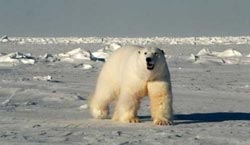How do polar bears stay warm?

A male polar bear. Credit: U.S. Geological Survey, Steven C. Amstrup<br>
New study is part of a broader genomic research program aimed at understanding what makes a polar bear a polar bear
In the winter, brown and black bears go into hibernation to conserve energy and keep warm.
But things are different for their Arctic relative, the polar bear. Within this high-latitude species, only pregnant females den up for the colder months.
So how do the rest survive the extreme Arctic winters?
New research points to one potential answer: genetic adaptations related to the production of nitric oxide, a compound that cells use to help convert nutrients from food into energy or heat.
In a new study, a team led by the University at Buffalo reports that genes controlling nitric oxide production in the polar bear genome contain genetic differences from comparable genes in brown and black bears.
“With all the changes in the global climate, it becomes more relevant to look into what sorts of adaptations exist in organisms that live in these high-latitude environments,” said lead researcher Charlotte Lindqvist, PhD, UB assistant professor of biological sciences.
“This study provides one little window into some of these adaptations,” she said. “Gene functions that had to do with nitric oxide production seemed to be more enriched in the polar bear than in the brown bears and black bears. There were more unique variants in polar bear genes than in those of the other species.”
The paper, titled “Polar Bears Exhibit Genome-Wide Signatures of Bioenergetic Adaptation to Life in the Arctic Environment,” appeared Feb. 6 in the journal Genome Biology and Evolution.
Co-authors include scientists from UB, Penn State University, the U.S. Geological Survey Alaska Science Center, Durham University and the University of California, Santa Cruz.
The genetic adaptations the research team saw are important because of the crucial role that nitric oxide plays in energy metabolism.
Typically, cells transform nutrients into energy. However, there is a phenomenon called adaptive or non-shivering thermogenesis, where the cells will produce heat instead of energy in response to a particular diet or environmental conditions.
Levels of nitric oxide production may be a key switch triggering how much heat or energy is produced as cells metabolize nutrients, or how much of the nutrients is stored as fat, Lindqvist said.
“At high levels, nitric oxide may inhibit energy production,” said Durham University’s Andreanna Welch, PhD, first author and a former postdoctoral researcher at UB with Lindqvist. “At more moderate levels, however, it may be more of a tinkering, where nitric oxide is involved in determining whether — and when — energy or heat is produced.”
The research is part of a larger research program devoted to understanding how the polar bear has adapted to the harsh Arctic environment, Lindqvist said.
In 2012, she and colleagues reported sequencing the genomes of multiple brown bears, black bears and polar bears.
In a paper in the Proceedings of the National Academy of Sciences, the team said comparative studies between the DNA of the three species uncovered some distinctive polar bear traits, such as genetic differences that may affect the function of proteins involved in the metabolism of fat — a process that’s very important for insulation.
In the new study, the scientists looked at the mitochondrial and nuclear genomes of 23 polar bears, three brown bears and a black bear.
The research was funded by the University at Buffalo and the National Fish and Wildlife Foundation.
Media Contact Information
Charlotte Hsu
Media Relations Manager,
Architecture, Economic Development, Sciences, Urban and Regional Planning
Tel: 716-645-4655
chsu22@buffalo.edu
Media Contact
More Information:
http://www.buffalo.edu/news/releases/2014/02/014.htmlAll latest news from the category: Life Sciences and Chemistry
Articles and reports from the Life Sciences and chemistry area deal with applied and basic research into modern biology, chemistry and human medicine.
Valuable information can be found on a range of life sciences fields including bacteriology, biochemistry, bionics, bioinformatics, biophysics, biotechnology, genetics, geobotany, human biology, marine biology, microbiology, molecular biology, cellular biology, zoology, bioinorganic chemistry, microchemistry and environmental chemistry.
Newest articles

Recovering phosphorus from sewage sludge ash
Chemical and heat treatment of sewage sludge can recover phosphorus in a process that could help address the problem of diminishing supplies of phosphorus ores. Valuable supplies of phosphorus could…

Efficient, sustainable and cost-effective hybrid energy storage system for modern power grids
EU project HyFlow: Over three years of research, the consortium of the EU project HyFlow has successfully developed a highly efficient, sustainable, and cost-effective hybrid energy storage system (HESS) that…

After 25 years, researchers uncover genetic cause of rare neurological disease
Some families call it a trial of faith. Others just call it a curse. The progressive neurological disease known as spinocerebellar ataxia 4 (SCA4) is a rare condition, but its…





















